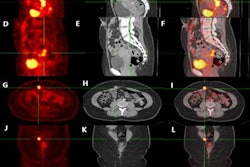
Utilization rates of CT colonography (CTC) are low, which prompts concern over whether patients at risk of colon cancer are getting the screening they need, according to a study published April 28 in the Journal of the American College of Radiology.
A team led by Dr. Brandon O'Connor of the University of the Incarnate Word of Osteopathic Medicine in San Antonio, TX, found that in 2019, the annual rate of CTC use among eligible individuals was only 1.4% -- which suggests that efforts to boost CTC screening are definitely needed, the group wrote.
"Patient education about CTC and other colorectal cancer [screening] modalities available can help reduce barriers to colorectal cancer screening," the team noted.
In 2018, the U.S. Preventive Services Task Force (USPSTF) lowered the starting age for colon cancer screening from 50 to 45, expanding the pool of eligible individuals. Colon cancer screening can be done via CTC, fecal occult blood or immunochemical tests, flexible sigmoidoscopy, and colonoscopy, but the benefit of CTC is that it is minimally invasive and highly sensitive for detecting colon polyps.
Yet almost one-third of the eligible U.S. population is not receiving recommended colorectal cancer screening, O'Connor's team explained. And this lack of screening uptake can have particularly negative effects on underserved populations.
"[Underutilization of CTC] particularly effects racial and ethnic minority groups who face higher colorectal cancer mortality and are less likely to receive recommended screening compared to White non-Hispanics," the group wrote. "Increasing colorectal cancer screening participation rates is a foundational step to address existing disparities in colorectal cancer outcomes through early detection among underserved populations."
O'Connor and colleagues sought to assess nationwide utilization of CTC and identify any predictors for its use using data from the 2019 National Health Interview Survey. The study included 13,709 respondents, with only 1.4% reporting having undergone CTC for colorectal cancer screening.
The group found that Latinx and Black individuals were actually more likely to undergo CTC (rather than other forms of colorectal cancer screening) compared with their white counterparts.
| Odds of CTC use by race/ethnicity | |
| Race/ethnicity | Odds ratio (reference, 1) |
| White | Reference |
| Latinx | 2.67 |
| Black | 2.47 |
| American Indian or Alaskan Native | 1.28 |
| Other | 1.17 |
| Asian | 0.51 |
But the finding that Black individuals are more likely to undergo CTC doesn't change the fact that mortality rates among Black people, in particular, remain high.
"Colorectal cancer incidence and mortality rates are highest among Black populations, suggesting that targeted interventions to improve screening rates in this at-risk population could reduce disease-specific mortality," O'Connor and colleagues wrote.
Previous studies have found that patients often prefer CTC compared with other colon cancer screening tools, since it's less invasive, according to the authors.
"[One study] found that patients who had experienced both optical colonoscopy and CTC preferred CTC, and in future screenings would be more likely to choose [it]," they concluded. "Not only is CTC preferable for patients, but it may provide a more accessible option for patients."



















